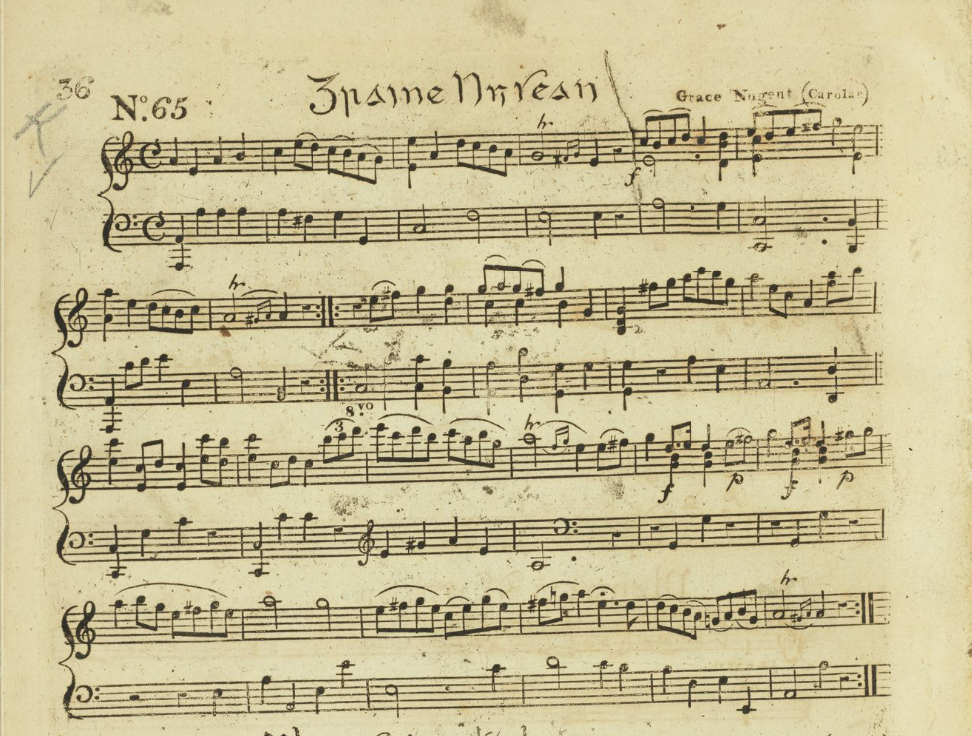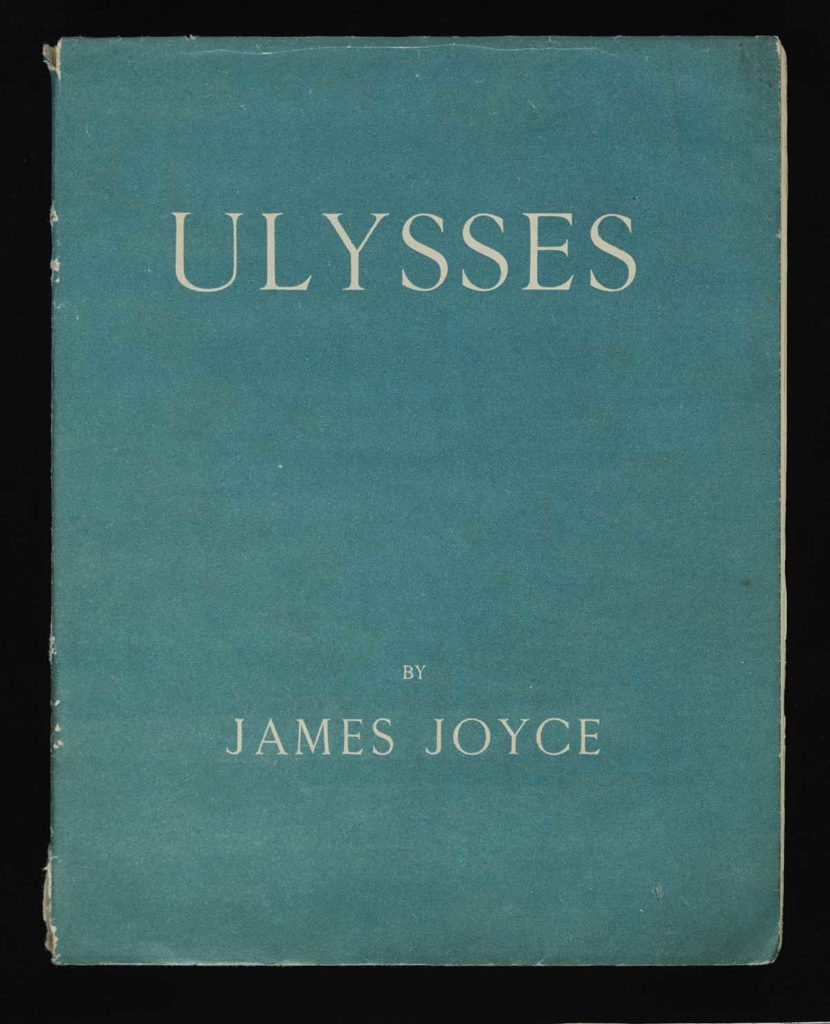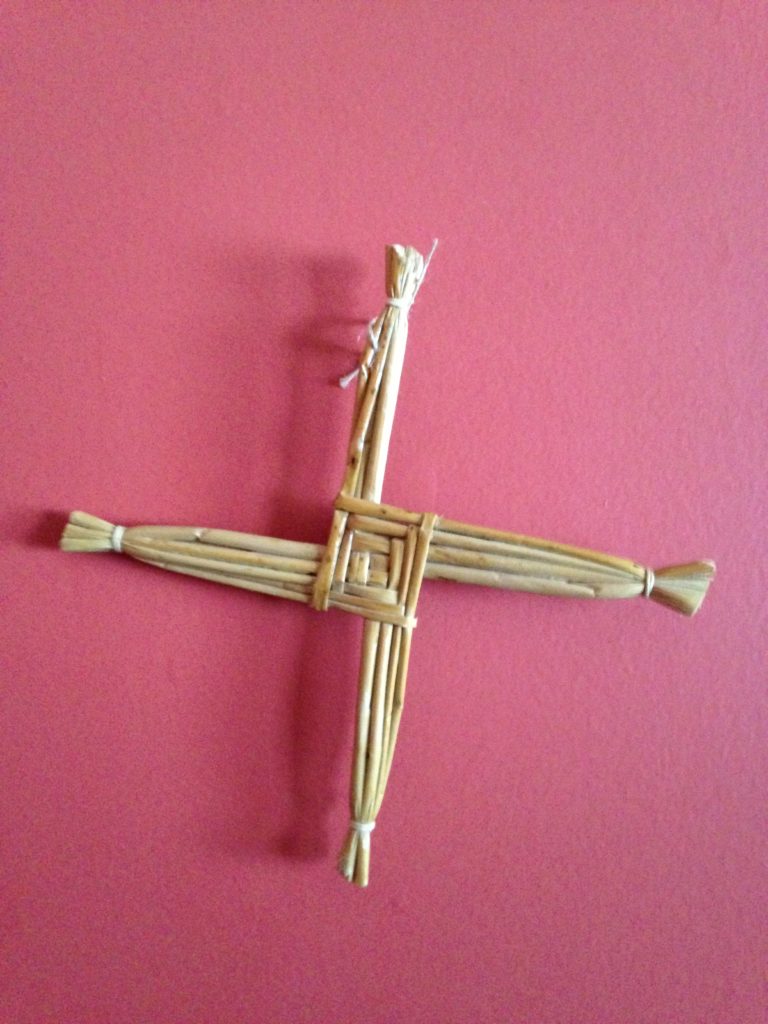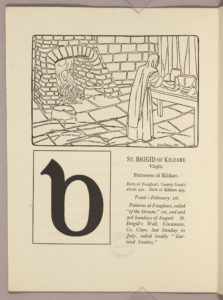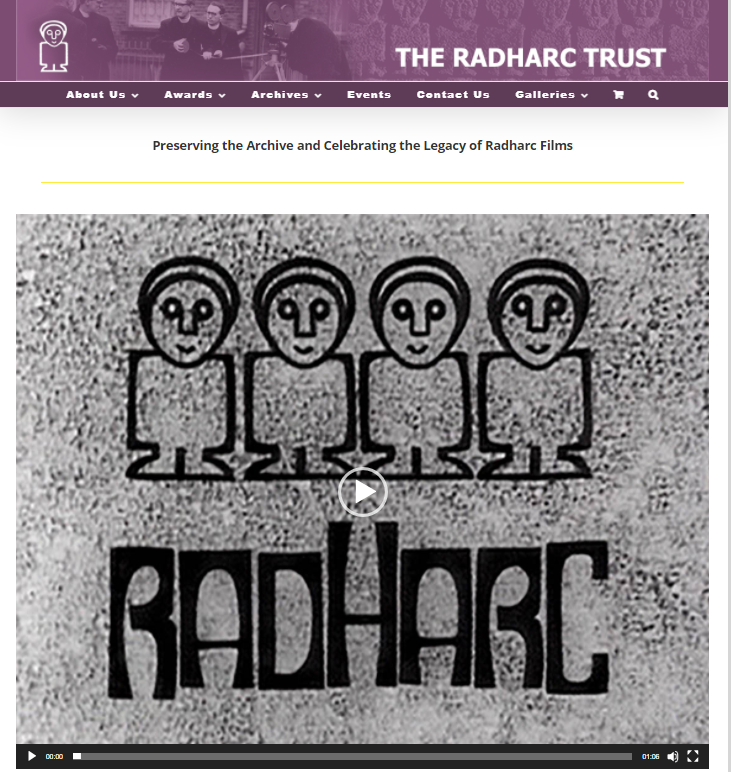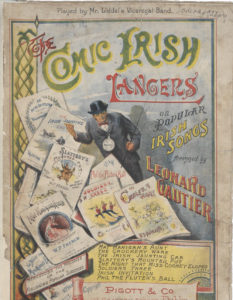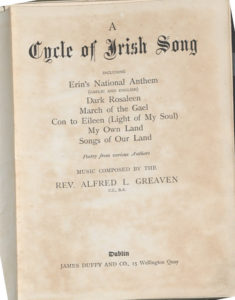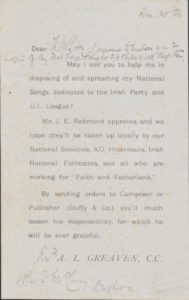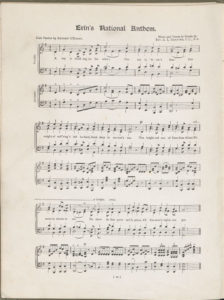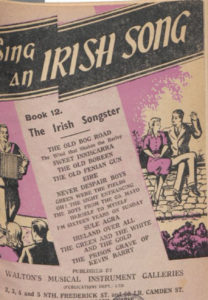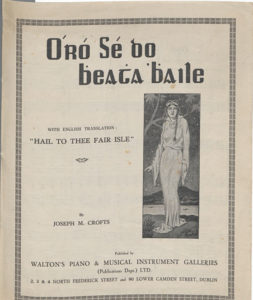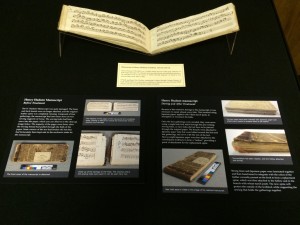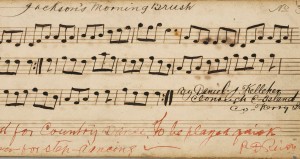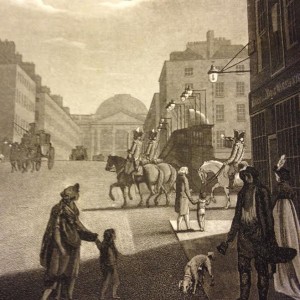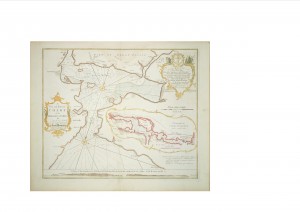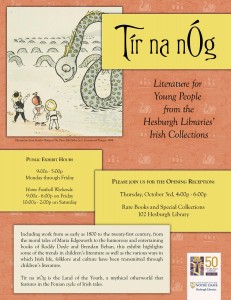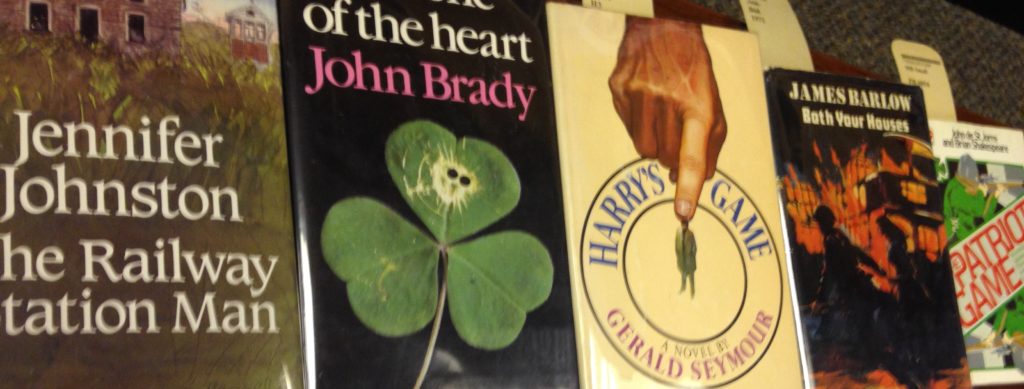
The Irish Fiction Collection is a very large collection of novels by Irish authors, set in Ireland, or with a significant Irish connection. It has its nucleus in the Loeber Collection of Irish Fiction, and it includes over 4,000 volumes. Books from the collection are available for reading in the Rare Books and Special Collections Reading Room.
Novels set during the Northern Ireland Conflict form a sub-collection. In building this collection, we acknowledge the work of Bill Rolston, whose bibliography, Literature of the ‘Troubles’: Novels was an invaluable reference.
The novels are listed below. * denotes novels that may be found in the circulating collections and borrowed.
Fiction and the Conflict in Northern Ireland – List of Titles in the Irish Fiction Collection.
Aalben, Patrick. The Grab. London: Robert Hale, 1977.
Adams, James. Taking the Tunnel. London: Michael Joseph, 1993.
Adams, Patrick. Everything can be O.K. Los Angeles: Amber International, 1979.
Anderson, Don. Heatshield. London: Pan, 1990.
Anderson, Linda. To Stay Alive. London: Bodley Head, 1984.
Anderson, Linda. Cuckoo. London: Bodley Head, 1986.*Anthony, Evelyn. A Place to Hide. New York: Putnam, 1987.
Anthony, Paul. The Fragile Peace. London: Janus, 1996.*
Armstrong, Campbell. Jig. London: Allison & Busby, 2007.
Ashe, Alex. An Acceptable Level of Violence. Gamlingay, Bedfordshire: Authors OnLine, 2008.
Atwater, James D. Time Bomb. New York: Viking, 1977.
Aylott, Bob. Cry for Tomorrow. London: Everest, 1973.
Baker, Keith. Inheritance.*
Ball, Brian. Keegan: The No-Option Contract. London: Barker, 1975.
Ballinger, W. A. The Green Grassy Slopes. London: Corgi, 1969.
Banks, Lynn Reid. Maura’s Angel. New York: Avon, 1998.
Barlow, James. Both Your Houses: A Novel. London: Hamilton, 1971.
Barton, Harry. Yours Again, Mr. Mooney. Belfast: Blackstaff, 1974.
Bateman, Colin. Belfast Confidential. London: Headline, 2005*
Bateman, Colin. Divorcing Jack. New York: Arcade, c.1995.*
Bateman, Colin. Empire State. London: HarperCollins, 1998.*
Bateman, Colin. I Predict a Riot. London: Headline, 2007.*
Bateman, Colin. Cycle of Violence. New York: Arcadia, 1996.*
Bateman, Colin. Maid of the Mist. London: HarperCollins, 1999.*
Bateman, Colin. Of Wee Sweetie Mice and Men. New York: Arcade, 1997.*
Bateman, Colin. The Day of the Jack Russell. London: Headline, 2010.
Beattie, Geoffrey. The Corner Boys. London: Gollancz, 1998.
Beckett, Mary. Give Them Stones. New York: Harper &Row, c. 1989.
Bennett, Colin. The Entertainment Bomb. London: New Futurist, 1996.
Bennett, Ronan. The Second Prison. London: Review, 2000.
Binchy, Dan. The Neon Madonna. London: Century, 1991.*
Binnie, Stewart. Across the Water. London: Secker & Warburgh, 1979.
Blain, Sean Martin. The Java Man. London: Michael Joseph, 1995.
Blair, Iain. Hooligan’s Rant. London: New English Library, 1979.
Blake, Philippa. Looking Out. London: Bodley Head, 1989.
Bradby, Tom. Shadow Dancer. New York: Bantam, 1998.
Braddon, Russell. The Progress of Private Lilyworth. London: Joseph, 1971.
Bradford, Roy. The Last Ditch. Belfast: Blackstaff, c. 1981.
Brady, John. A Stone of the Heart. Toronto: Collins, 1989.
Brady, John. Kaddish in Dublin. New York: St. Martin’s Press, 1992.
Brady, John. Unholy Ground. New York: St. Martin’s Press, 1992.
Breasted, Mary. Why Should You Doubt Me? New York: Farrar, Straus, Giroux, 1993.*
Breslin, Jimmy. World Without End, Amen. New York: Viking, 1973.*
Brewster, David. The Heart’s Grown Brutal. London: Angus & Robertson, 1972.
Bringle, Mary. The Man in the Moss-Colored Trousers. Garden City, NY: Doubleday, 1986.
Broderick, John. The Fugitives. New York: Obolensky, 1962.*
Brown, George. Ringmain. London: Barrie & Jenkins, 1991.
Broxon, Mildred Downey. Too Long a Sacrifice. New York: Dell, 1981.
Bullen, Fiona. From Pillar to Post. London: Warner, 1998.
Bunting, Eve. Walking to School. New York: Clarion, 2008.
Burns, Anna. No Bones. New York: Norton, 2002.
Burns, Richard. Why Diamond Had to Die. London: Bloomsbury, 1989.
Burton, Anthony. The Coventry Option. London: Unwin Hyman, 1987.*
Byrne, Robert. The Tunnel. New York: Harcourt Brace, c. 1977.
Caldwell, Lucy. All the Beggars Riding. London: Faber, 2013.
Caldwell, Lucy. Where They were Missed. NY: Viking, 2006.*
Cannon, Elliott. Stand By to Shoot. London: Hale, 1973.
Carrick, James. With O’Leary in the Grave. London: Heinemann, 1971.*
Carroll, James. Madonna Red. Boston: Little, Brown, c. 1976.*
Carter, Peter. Under Goliath. Oxford: OUP, 1977.
Case, James. Belfast Blitz. New York: Warner, c. 1987.
Casey, Kevin. Dreams of Revenge. London: Faber, 1977.
Cawley, Robert. Shockwave. London: Sphere, 1979.
Cazenave, Michel. Les Fusils de l’IRA. Paris: L’Herne, c. 1977.
Chaplin, Michael. Act of Betrayal. London: Corgi, 1988.
Chapman, John. City War. London: Hale, 1979.
Charles, Robert. The Hour of the Wolf. London: R. Hale, 1974.
Chipperfield, Joseph E. The Watcher on the Hills. London: Heinemann, 1968.
Clancy, Ambrose. Blind Pilot. New York: W. Morrow, 1980.
Clancy, Tom. Patriot Games. New York: Berkley, c. 1987.
Clarke, Shaun. Red Hand. London: Coronet, 1998.
Clarke, Shaun. Soldier E: SAS: Sniper Fire in Belfast. Maidstone: 22 Books, 1993.
Cleary, Jon. Peter’s Pence. New York: Morrow, c. 1974.
Clifford, Francis. Drummer in the Dark. New York: Harcourt, Brace, c. 1976.
Cole, John. A Clouded Peace. London: Weidenfeld, 2001.*
Connolly, Colm. The Pact. London: Andre Deutsch, 1980.
Coogan, Patrick. The General. London: Sinclair-Stevenson, 1993.
Costello, Mary. Titanic Town. London: Methuen, 1992.
Countryman, Albert J. The Streets of Derry. Palmyra, NJ: Countryman Pub., c. 1986.
Courts, Johnson. Collusion. London: Minerva, 1996.
Cowell, John. The Begrudgers. Dublin: O’Brien, 1978.
Crawford, Richard. Fall When Hit. London: Mandarin, 1993.
Cregan, Conor. With Extreme Prejudice. San Jose, CA: ToExcel, c. 2000.
Cunningham, Peter. Who Trespass Against Us. London: Century, 1993.
Daly, Ita. All Fall Down. London: Bloomsbury, 1993.*
Daniel, James. Out of the Strong. London: Pan, 1995.
Davies, Murray. The Drumbeat of Jimmie Sands. London: HarperCollins, 1999.
De Mille, Nelson. Cathedral. New York: Delacorte, 1981.
Desser, Julian. Soap Star Kidnapped: A Newspaper Novel. Southport: Tabloid Books, 1992.
de St. Jorre, John. The Patriot Game. London: Coronet, 1974.
De Villiers, Gerard. S.A.S. furie à Belfast. Paris: Plon, 1974.
Deane, Seamus. Reading in the Dark. New York: Knopf, 1997.*
Dickinson, Peter. The Green Gene. London: Hodder & Stoughton, c. 1973.
Dillon, Martin. The Serpent’s Tail. London: R. Cohen, 1995.
Donnelly, Joe. The Shee. London: Century, 1992.
Douglas, James. The Clearing. Melbourne, Australia: Perfect Publ., 1994.
Dowd, Siobhán. Bog Child. Oxford: David Fickling, 2008.
Dowling, Kevin. Interface Ireland. London: Barrie & Jenkins, 1979.
Driscoll, Peter. In Connection with Kilshaw. Philadelphia, PA.: Lippincott, 1974.
Drummond, June. Bang! Bang! You’re Dead. London: Gollancz, c. 1973.
Duffaud, Briege. A Wreath Upon the Dead. Dublin: Poolbeg, 1994.
Dunne, Lee. Ringmaster. Dublin: Wolfhound, 1986.
Edwards, Ruth Dudley. The Anglo-Irish Murders. London: HarperCollins, 2000.*
Egleton, Clive. The Mills Bomb. London: Hodder and Stoughton, 1978.
Eickhoff, Randy Lee. The Gombeen Man. New York: Walker, 1992.
Esler, Gavin. Loyalties. London: Headline, 1990.
Feeney, John. Worm Friday. Dún Laoghaire: Anna Livia, c. 1974.*
Finlay, Fergus. A Cruel Trade. London: A. Deutsch, 1990.
Foley, Michael. Getting Used to Not Being Remarkable. Belfast: Blackstaff, 1998.*
Forsyth. The Deceiver. New York: Bantam, 1992.*
Gadney, Reg. Just When We Are Safest. London: Faber, 1995.*
Gallie, Menna. You’re Welcome to Ulster! London: Gollanz, 1970.
Garfield, Brian. The Paladin. New York: Simon and Schuster, c. 1979.Gibbons, Alan. The Defender. London: Orion, 2004.
Gibson, Elizabeth. The Water is Wide. Grand Rapids, MI: Zondervan, c. 1984.
Gibson, Tom. A Wild Hope. London: Hale, 1983.
Gill, B. M. Target Westminster. Halifax, UK: Remploy, c. 1977.
Gill, Bartholomew. McGarr and the Politician’s Wife. New York: Scribner, c. 1977.
Gill, Bartholomew. McGarr and the P.M. of Belgrave Square. New York: Viking Press, 1983.
Gill, Bartholomew. McGarr and the Method of Descartes. New York: Viking, 1984.*
Gill, Bartholomew. McGarr at the Dublin Horse Show. New York: Scribner, c. 1979.
Grant, David. Emerald Decision. New York: Hold, Rinehart, c. 1980.*
Gray, Pat. The Political Map of the Heart. Sawtry: Dedalus, 2001.*
Gross, Ken. Hell Bent. New York: T. Doheny, 1992.
Hale, John. Lovers and Heretics. London: Gollanz, 1976.
Hamill, Desmond. Bitter Orange. London: Hutchinson, 1979.*
Hamill, Pete. The Guns of Heaven. London: Titan, 2011.
Hanley, Clifford. Prissy. London: Collins, 1978.
Harcourt, Palma. A Sleep of Spies. London: Collins, 1979.
Harris, Peter. A Solitary Terrorist. Lewes, Sussex: Book Guild, 1987.
Hawke, Christopher. For Campaign Service. London: Corgi, 1979.
Hayward, David. The Provo Link. London: Hale, 1979.
Healy, Dermot. Fighting with Shadows. Champaign, IL: Dalkey Archive Press, 2015.
Healy, Dermot. A Goat’s Song. New York: Viking, 1995.
Hegarty, David. Short Storm. Cork: Emperor, 1991.
Herron, Shaun. The Hound and the Fox and the Harper. New York: Berkley, 1971.
Herron, Shaun. Through the Dark and Hairy Wood. London: Cape, 1973.
Herron, Shaun. The Whore Mother. London: Cape, 1973.
Higgins, Jack. The Savage Day. Greenwich, CT.: Fawcett, 1974.
Higgins, Jack. The Violent Enemy. London: Harper, 2008.
Higgins, Jack. Drink With the Devil. London: Michael Joseph, c. 1996.
Higgins, Jack. Angel of Death. New York: Putnam’s, c. 1995.
Higgins, Jack. A Prayer for the Dying. London: Collins, 1973. (+film)
Hill Niki. Death Grows on You. London: M. Joseph, 1993.
Hilliar, Michael. Come Dance with Me. Belfast: Blackstaff, 1977.
Higgins, George V. The Patriot Game. New York: Knopf, 1982.
Hogan, Desmond. A Curious Street. New York: G. Brazilliar, 1984.
Hogan, Desmond. A New Shirt. London: Hamish Hamilton, 1986.
Holland, Jack. The Prisoner’s Wife. New York: Dodd, Mead, c. 1981.
Holland, Jack. Walking Corpses. Dublin: Torc, 1994.
Holloway, Rupert. The Terrorist Conspiracy. Lewes: Book Guild, 1982.
Howlett, John. Orange. London: Hutchinson, 1985.
Hurd, Douglas. Vote to Kill. London: Collins, 1975.
Hurley, Graham. Reaper. London: Macmillan, 1991.
Hutson, Shaun. Knife Edge. London: Little Brown, 1997.
Hutson, Shaun. White Ghost. London: Little Brown, 1994.
Hynes, James. The Wild Colonial Boy. New York: Athaneum, 1990.
Ingoldby, Grace. Across the Water. London: Michael Joseph, 1985.
Jacks, Oliver. Assassination Day. London: Hodder and Stoughton, 1976.
Jacobsen, Keith. Place of a Skull. London: Thames River Press, 2013.
James, Evelyn. Taking the Forbidden Road. Holywood, Northern Ireland: Third House, 1991.
Johnston, Jennifer. Shadows on Our Skin. London: Hamish Hamilton, 1977.
Johnston, Jennifer. The Railway Station Man. London: Hamish Hamilton, 1984.
Jones, R. W. The Green Reapers. London: Michael Joseph, 1988.
Joyce, Joe. Off the Record. London: Heinemann, 1989.
Joyce, Joe. The Trigger Man. New York: Norton, 1991.
Judd, Alan. A Breed of Heroes. New York: coward, McCann & Geoghegan, 1981.
Kavanagh, P. J. Only By Mistake. New York: Riverrun Press, 1986.
Kelly, James. The Marrow From the Bone. Bailieboro, Co. Cavan: Kelly Kane, 1987.
Kennedy, James. Armed and Dangerous. London: Mandarin, 1996.
Kerrigan, Philip. Dead Ground. New York: St. Martin’s, 1985.*
Kiely, Benedict. Proxopera. Boston: Godine, 1987*
Kiely, Benedict. Nothing Happens in Carmincross. Boston: Godine, 1985.
Kilcommon, Denis. Serpent’s Tooth. New York: Bantam, 1989.
Kippax, Frank. Other People’s Blood. London: HarperCollins, 1992.
Lane, Andrew. Forgive the Executioner. London: New English Library, 1978.
Lauder, Peter. Noble Lord. London: Fontana, 1986.
Laurence, Jyl. Un Coeur en Irlande. Paris: Flammarion, 1996.
Leitch, Maurice. Chinese Whispers. London: Hutchinson, 1987.
Le Meur, Dominique. Où vas-tu Irlande?. Spézet: Coop Breizh, 1998.
Leather, Stephen. The Chinaman. London: Hodder & Stoughton, 1992.
Leitch, Maurice. Poor Lazarus. Belfast: Blackstaff, 1985.
Leitch, Maurice. Silver’s City. Londin: Minerva, 1995.
Leland, Mary. Approaching Priests. London: Sinclair-Stevenson, 1991.
Lingard, Joan. Across the Barricades. London: Hamilton, 1972.
Lingard, Joan. The Lord on Our Side. London: Hodder & Stoughton, 1970.
Lingard, Joan. The Guilty Party. London: Hamish Hamilton, 1987.
Lingard, Joan. Hostages to Fortune. London: Puffin, 1995.
Lingard, Joan. A Proper Place. Nashville: T. Nelson, 1975.
Lingard, Joan. Into Exile. Nashville: T. Nelson, 1973.
Lingard, Joan. The Twelfth Day of July. London: Puffin, 1996.
Maas, Peter. Father and Son. New York: Simon & Schuster, 1989.*
MacAnthony, Joseph. The Setanta Operation. London: Grafton, 1991.
MacDowell, Vincent. An Ulster Idyll. Dublin: Annamount, 1989.
MacLaverty, Bernard. Cal. New York: Bloomsbury, 2014.*
Madden, Deirdre. Hidden Symptoms. Boston: Atlantic Monthly Press, 1986.
Madden, Deirdre. One By One in the Darkness. Boston: Faber, 1996.
Martin, David. The Task. London: Secker &Warburg, 1975.
Martin, David. The Ceremony of Innocence. London: Secker & Warburg, 1969.*
May, Naomi. Troubles. London: Calder, 1976.
McBratney, Sam. Mark Time. London: Abelard-Schuman, 1976.
McCabe, Eugene. Victims. London: gollancz, 1976.*
McCabe, Patrick. Carn. London: Picador, 1993.*
McCabe, Patrick. Breakfast on Pluto. New York: HarperPerennial, 1999.* (and film on DVD)
McCartan, Dominic. Operation Emerald. New York: Dembner, 1985.
McCarthy, Thomas. Without Power. Dublin: Poolbeg, 1991.
McCaughren, Tom. Rainbows of the Moon. Dublin: Anvil, 1989.
McCrum, Robert. The Psychological Moment. London: Secker & Warburg, 1993.
McEldowney, Eugene. A Kind of Homecoming. New York: St. Martin’s, 1994.
McEldowney, Eugene. A Stone of the Heart. London: Mandarin, 1996.*
McGeough, Gerry. Defenders. Monaghan: Seesyu Press, 1998.
McKeon, James. Operation Pontiff. Cork: Acorn, 1994.
McKinty, Adrian. The Cold, Cold Ground. London: Serpent’s Tail, 2012.
McLoughlin, Jane. Coincidence. London: Virago, 1992.
McMahon, Blair. Nights in Armour. Lurgan: Ulster Society Publications, 1993.
McNamara, Michael. The Dancing Floor. New York: Crown, 1978.
McNamee, Eoin. Last of Deeds. New York: Picador, 1996.
McNamee, Eoin. Orchid Blue. London: Faber, 2010.*
McNamee, Eoin. Resurrection Man. London: Picador, 1994.*
McVeigh, Paul. The Good Son. Cromer, Norfolk: Salt, 2015.
Mealy, Colm. Operation Falco. London: Minerva, 1998.
Michaels, S. J. Dieback. London: Pan, 1992.
Michaels, Sarah. Summary Justice. London: Frederick Muller, 1988.
Miles, Monty. Reasonable Maniacs: For the Love of Northern Ireland. San Jose: Writers Club Press, 2000.
Miner, Valerie. Blood Sisters. London: The Women’s Press, 1981.
Mitchell, Julie. Sunday Afternoons. London: Viking, 1988.*
Mitchell, Susanna. The Colour of His Hair. London: Allison & Busby, 1994.
Molloy, Frances. No Mate for the Magpie. London: Virago, 1985.*
Molloy, Pat. A Legacy of Demons. Llandysul: Gomer, 1989.
Moore, Brian. Lies of Silence. London: Bloomsbury, 1990.*
Mornin, Daniel. All Our Fault. London: Hutchinson, 1991.
Morrow, John. The Confessions of Proinsias O’Toole. Belfast: Blackstaff, 1977.*
Morrow, John. The Essex Factor. Belfast: Blackstaff, 1982.
Nelson, Walter. The Minstrel Code. London: Secker & Warburg, 1979.
Neville, Stuart. The Final Silence. New York: Soho, 2014.
Neville, Stuart. The Ghosts of Belfast. New York: Soho, 2009.
Newman, G. F. The Testing Ground. London: Sphere, 1989.
Nicholl, Ned. No More Leprechauns. London: New English Library, 1975.
Nolan, Frederick. Designated Assassin. London: Arrow, 1991.
North, Michael. Mission to Ulster. London: Dennis Dobson, 1981.
Ó Doibhlin, Breandán. An Branar Gan Cur. Dublin: Sairséal Ó Marcaigh, 1979.
Ó Siadhail, Pádraig. Éagnairc. Indreabhán: CIC, 1994.
O’Brien, Edna. House of Splendid Isolation. New York: Farrar Straus, 1994.
O’Callaghan, Gareth. Dare to Die. Dublin: Poolbeg, 1996.*
O’Connor, Brian. The One-Shot War. New York: Times Books, 1980.
O’Doherty, Malachi. Belfast Story. Whitley Bay: Erdesdun Pomes, 1976.
O’Donovan. Uinsin. Rag Shadows. Dublin: Cill Enna, 1980.
O’Mahony, T. P. The Lynch Years: A Political Fantasy. Mountrath, Portlaoise: Dolmen, 1986.
O’Neill, Edward A. The Rotterdam Delivery. New York: Coward, McCann & Geoghegan, 1975.
O’Reilly, Victor. Games of the Hangman. Headline, 1992.
O’Sullivan, Mark. Silent Stones. Dublin: Wolfhound, 1999.
Ould, Chris. A Kind of Sleep. London: A. Deutsch, 1986.
Paisley, Rhonda. Lost Fathers. Belfast: Ambassador Productions, 1995.
Park, David. The Healing. London: Phoenix, 1993.
Park, David. Stone Kingdoms. London: Bloomsbury, 2015.
Park, David. The Rye Man. London: Jonathan Cape, 1994.
Patrick, Sean. Maureen’s Ireland. Seán Patrick, 1986.
Patterson, Glenn. Burning Your Own. London: Minerva, 1993.
Patterson, Glenn. Fat Lad. London: Chatto & Windus, 1992.*
Patterson, Glenn. The International. London: Anchor, 1999.*
Patterson, Glenn. The Rest Just Follows, or Up Here. London: Faber, 2014.*
Patterson, Harry. Cry of the Hunter. London: World Distributors, 1963.
Perry, Ritchie. Dead End. London: Collins, 1977.
Petit, Chris. The Psalm Killer. New York: Fawcett Gold Medal, 1998.
Pincher, Chapman. The Eye of the Tornado. London: Sphere, 1978.
Power, M. S. The Killing of Yesterday’s Children. New York: Viking, 1986.
Power, M. S. A Darkness in the Eye. London: Heinemann, 1987.
Quigley, Patrick. Borderland. Dingle: Brandon, 1994.*
Quinn, John. Generations of the Moon. Dublin: Poolbeg, 1995.*
Rae, Hugh C. Whip Hand. London: Sphere, 1974.
Ransley, Peter. The Price. London: Severn House, 1985.
Renwick, Aly. …Last Night Another Soldier. London: Information on Ireland, 1989.
Rice, David. Blood Guilt. Belfast: Blackstaff, 1994.*
Rooney, Seán. Early Many a Morning. Dingle: Brandon, 1994.
Rowe, John. Long Live the King. New York: Stein and Day, 1984.
Royce, Kenneth. A Wild Justice. London: Hodder & Stoughton, 1992.
Ryan, Chris The Watchman. London: Century, 2001.
Scott, Hardiman. Operation 10. Sevenoaks: Coronet, 1983.
Seaman, Donald. The Committee. New York: Atheneum, 1978.
Sefton, Catherine. Along a Lonely Road. London: Hamilton, 1991.
Sefton, Catherine. The Beat of the Drum. London: Walker, 2001.
Sefton, Catherine. Frankie’s Story. London: Walker, 2000.
Seymour, Gerald. The Contract. New York: Holt, Rinehart and Winston, 1981.
Seymour, Gerald. The Journeyman Tailor. New York: Edward Burlingame, 1992.
Seymour, Gerald. Field of Blood. Glasgow: Fontana/Collins, 1986.
Seymour, Gerald. The Glory Boys. New York: Random House, 1976.
Seymour, Gerald. Harry’s Game. New York: Random House, 1975.
Shannon, James. A Game of Soldiers. London: Sphere, 1985.
Shea, Michael. Spin Doctor. London: HarperCollins, 1996.*
Shelley, Mike. The Last Private Eye in Belfast. Belfast: Domino, 1984.
Sherman, Eileen. The Divided Heart. Leicester: Ulverscroft, 1998.
Shriver, Lionel. The Bleeding Heart. New York: Farrar, Straus, 1990.
Silva, Daniel. The Marching Season. London: Orion, 2001.
Smith, Murray. A Gun for Delilah. London: Robert Hale, 1979.
Spain, Peter. Blood Scenario. New York: Coward, McCann & Geoghegan, 1980.
Stevens, Gordon. Provo. London: HarperCollins, 1993.
Strong, Terence. The Tick Tock Man. London: Heinemann, 1994.
Stuart, Francis. Memorial. Dublin: Raven Arts, 1984.
Stuart, Francis. A Hole in the Head. Nantucket, MA.: Longship Press, 1977.
Symons, Julian. The Detling Secret. New York: Viking, 1983.
Target, George W. The Patriots. London: Duckworth, 1974.
Taylor, Patrick. Now and in the Hour of Our Death. New York: Forge, 2014.
Theroux, Paul The Family Arsenal. Boston: Houghton Mifflin, 1976.
Thomas, David. Anger’s Violin. Dingle: Mount Eagle, 1998.
Thompson, David. Broken English. New York: Henry Holt, 1988.
Urch, Marion. Violent Shadows. London: Headline Review, 1996.
Valentine, Deborah. Fine Distinctions. New York: Avon, 1991.
Van Greenaway, Peter. Suffer! Little Children. London: Gollancz, 1976.
Waddell, Martin. The Beat of the Drum. London: Walker, 1989.
Waddell, Martin. Come Back When I’m Sober. London: Hodder & Stoughton, 1969.
Waddell, Martin. Frankie’s Story. London: Walker Books, 1988.
Waddell, Martin. A Little Bit British. London: Tom Stacey, 1970.
Walker, Martin. The Infiltrator. New York: Dial, 1978.
Wead, R. Douglas. Tonight They’ll Kill a Catholic. Carol Stream, IL: Creation House, 1974.
Weber, Katherine. The Music Lesson. New York: Crown, 1998.*
West, Tara. Fodder. Belfast: Blackstaff, 2002.
Weston, Simon. Cause of Death. Rochester: 22 Books, 1996.
White, Jon Manchip. The Robinson Factor. Frogmore, Hertfordshire: Panther, 1976.
White, Steve. The Fighting Irish. New York: Warner, 1982.
White, Stuart. The Shamrock Boy. London: Bodley Head, 1990.
White, Terence de Vere. The Distance and the Dark. Boston: Gambit, 1973.
Wilson, Des. The Demonstration. Belfast: Desmond Wilson, 1982.
Wilson, Robert McLiam. Ripley Bogle. Belfast: Blackstaff, 1989.*
Wilson, Robert McLiam. Eureka Street. London: Secker & Warburg, 1991.
Wilson, Stewart J. The Gobbins. London: Minerva, 1997.
Winch. Arden. Blood Money. London: British Broadcasting Corp., 1981.
Wood, James. Road to Canossa. London: Hutchinson, 1971.
Woods, Una. The Dark Hole Days. Belfast: Blackstaff, 1984.
Wright, Glover. Headhunter. London: Macmillan, 1994.
Updated, July 19, 2018.
